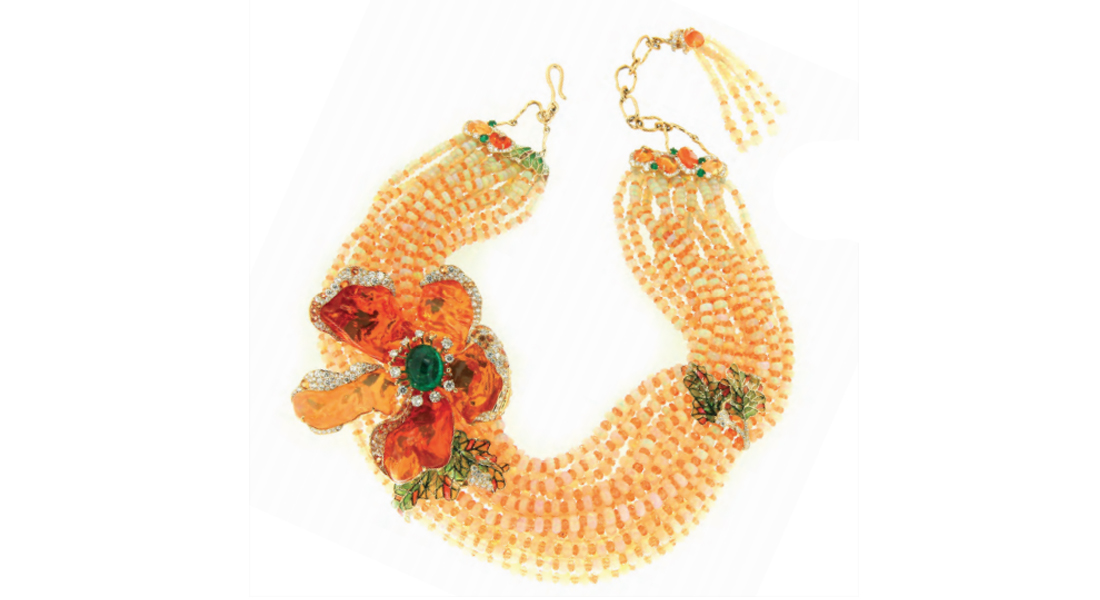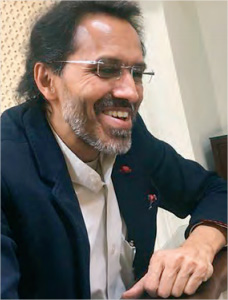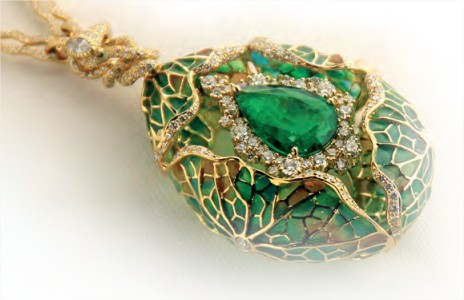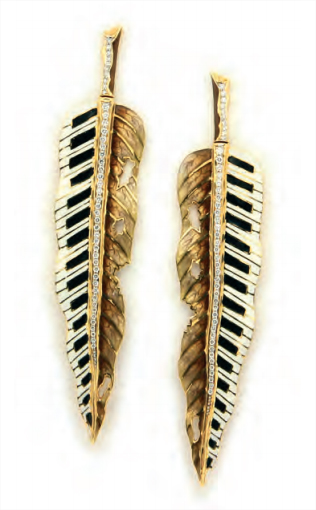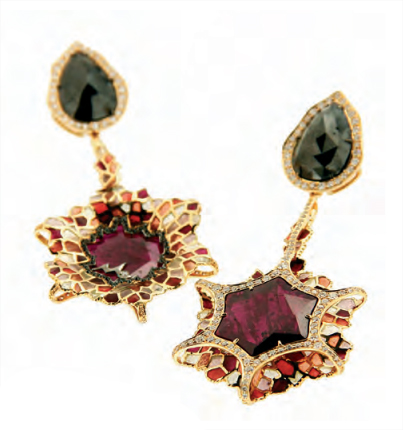Anup Bohra, CEO and managing director, Jewels Emporium, Jaipur, is way ahead of his times. A patron of jewellery arts and crafts, his forwardthinking vision has helped him popularise his limited edition collection Masterstrokes globally. He and his team have been pioneers in introducing French enamelling techniques in fine jewellery in India. The sole purpose that keeps his creative and adventurous spirit alive is the desire that India must be recognised not just for its traditions, but for its talent, innovation and artistic excellence. A brave heart, he opts to tread paths that are difficult in order to create something original. Bohra puts it aptly, “If you succeed in everything that you are doing, it means that you are attempting things that are far too easy. Thus, I choose paths where failure is inevitable initially, yet if you are persistent and have the courage to stay original, you will succeed. It isn’t the mind that creates beautiful work, it’s the soul!”
Jewels Emporium, Jaipur, has been a pioneer in introducing the art of Plique-à-jour and Basse-taille enamelling in India. Tell us about the journey. Why did Jewels Emporium bring the French enamelling techniques into India?
In 1983, I joined Jewels Emporium after graduating from the Gemological Institute of America (GIA) and started assisting my father and grandfather in the business. We were well established in retailing to foreign tourists, but it did not intrigue me enough to continue doing the same thing day in and day out. I was doing a lot of soul-searching to create an identity where I could not only build my company into a brand, but I could also take India to the world.
After much deliberation and research, along with my better half, Smriti, I decided to explore the world of enamelling. Colours always bring out evocative emotions. The beauty of a jewel is boundlessly enhanced when colour is added to it in the right proportion and combination. And since colours excite both me and Smriti, exploring enamelling techniques was an obvious choice. Further, we realised that enamel in India, especially Jaipur, was only being used in the traditional format.
Enamelling, or what is termed as meenakari, is said to have flourished under Raja Mansingh of Jaipur, who brought experts from Lahore to set up karkhanas (workshops) to popularise the technique of Champlevé enamelling. Since then, the technique was being used on the back of jadau jewellery to enhance its life. The palette was limited to six or seven colours, which were used as solid hues in flat engraved geometric shapes from Islamic tradition, interwoven with patterns displaying acanthus, birds, flowers and animal forms of Hindu aesthetics.
While studying further about the history of enamel art, we came across Art Nouveau jewellery and we were intrigued by the experimentation of that time. It was a eureka moment for me; it provided me a direction. One thing led to another, and soon we started understanding, exploring and appreciating French enamelling in our atelier. Brilliant minds and the script in place, we were ready for laying the foundation of a new chapter in the history of contemporary jewellery in India; the search for talented craftsmencum-artists began, which finally culminated in West Bengal.
We then embarked on this journey of turmoil and challenges. We failed many times only to try again and again. We wanted to break the traditional barriers.
Soon, we experimented and introduced the techniques of Plique-à-jour and Basse-taille along with Champlevé, bringing the colours from the back to the front of the jewel.
We found single, solid colours lifeless. Hence, we tried and achieved shading of not just dark to light, but also shading of two or more different colours. We live in a three-dimensional world, then how can enamel be restricted only to flat surfaces?
We conquered our next challenge of deploying enamel in contoured forms. The more we explored the more we achieved and that gave us the impetus to be more adventurous!
Today, we have a palette of almost 300 enamel hues and we can proudly say that we have pioneered French enamelling in India with reference to its use in contemporary jewellery. We started this journey in 2001, and today our avant-garde jewellery brand Masterstrokes is known for revolutionising and crafting unique pieces of wearable art, not just in India but in many other countries too.
Please throw light on the techniques for our readers and how difficult it is to achieve the finesse in fine jewellery. What are the hurdles that a manufacturer or a designer faces, and how long does it take to make a piece clad with these enamelling processes?
First let’s understand what fine jewellery is. Simply put, when a well-thought-out design is created responsibly, using quality materials, while adhering to international standards, the result is a jewel that speaks excellence.
And how you achieve this excellence is even simpler! Just don’t compromise at any level and never stop learning and innovating. When I see a piece of jewellery that I made a few years ago with my team, we brainstorm to find flaws and demerits and constructively proceed in raising our standards of excellence to a higher level.
Today, owing to this consistent creative post-mortem, we have evolved to create tell-tale marvels of fine jewellery and extraordinary wearable art!
I assure you, this is a neverending pursuit of experimenting and going a step ahead each time you create a thing of beauty. Any art, when explored, poses new challenges every day.
Referring particularly to French enamelling, we faced challenges from achieving the right amount of heating, to which colour combinations looked good, to how we can best enamel on curved surfaces and much more. It’s not possible to compress my experiences of so many years in just a few words. I could probably write a book on it!
The key is to keep questioning one’s own skills and be your own harshest critic. Further, there is no specific parameter on how long it takes to create a jewel dressed with French enamel. Some jewels may take as long as six months to a year! It all depends on the intricacy and details of the design.
We would like to know about the first collection that was enhanced with this technique. How long did it take you to complete the collection?
We were making single pieces for a long time before I had a crazy idea to make a collection inspired by the mesmerising peacock. The inspiration was not new, peacocks have always been used in Indian jewellery; but that was the challenge, to portray the peacock in a radically different way, yet make it appealing for the Indian clientele. At that time, we were focussing only on the Indian customer before embarking on our international journey. To top it, I don’t know why, but I wanted to create an enormous 80-piece collection, which we titled Romance of the Peacock! It took some years to come up with that number prior to the launch.
Importantly, how did it fare in the Indian market? Where did you first introduce the collection?
I had decided to launch the collection at Jaipur Jewellery Show (JJS) 2006, but I was getting the jitters when we completed 45 pieces in the Peacock collection! This fear led me to start selling much in advance than the JJS. The collection did extremely well. In fact, I was able to sell approximately 40 pieces even before I introduced the collection at JJS 2006! We re-launched the collection with new pieces at IIJW 2011.
What gives Champlevé an edge over other types of enamelling techniques?
It’s not the Champlevé, Pliqueà-jour or Basse-taille enamelling techniques that have an edge over the others; it’s how you deploy the technique in jewellery that gives it an edge. We used the same old technique, but we tweaked it. From a passive existence we made enamel a proactive element of the design. We made it as important as the gold, diamonds, coloured stones and the form of the design. We then enlightened the customer to change their perception, from buying jewellery for its material value, to buying jewellery for its astonishing work – the enamel work!
Let me put it on record, the Indian customer was in awe with our French enamelling works of art!
How did you get the metal workers and enamellers to train in this technique? Or did you import and adapt the art?
When I forayed into this journey of experimentation, I already had a team of artists who could dream design, manufacturing experts who were ready to face challenges, and my better half whose understanding of colours was par excellence!
We went all the way to Kolkata to bring the artisans to Jaipur; fortunately they, too, were willing to share our passion and enthusiasm. To develop any art form, someone must patronise it. In olden times, kings were the patrons. Today, someone like us, one who has the vision beyond just making money, must do it. When you develop or adapt art, which we did, there are no manuals for training; it’s not a technology one can import just through reading.
I had never acquired any professional training on enamelling. Thus, at Jewels Emporium, we continuously had to brainstorm, accept challenges, find solutions and were busy perfecting the art. Though, now I can pretty much create a manual for someone else to train; at that time we just followed our instincts, came up with our own methods to achieve what we have achieved today. The only disadvantage is that it takes a painstakingly long time to reach this level. Yet, it is extremely gratifying! Today, I have a team of gifted artists who are involved in the entire process, from getting the design on paper to the completion of the jewel.
But I have not restricted myself to this art form. I simply want to develop craft techniques of any kind to a high standard of excellence, whereby it is a piece of distinctive art which is appreciated globally.
In 2012, we participated in the ‘Craft to Jewellery’ project of the GJEPC where we incorporated the unique crafts of bamboo and bidri into fine jewellery.
Do you also have elements of enamel in your limited and signed edition Masterstrokes?
Every Masterstrokes jewel exhibits one or a combination of French enamelling techniques. It may be Champlevé, Plique-à-jour or Basse-taille. And, inevitably, every Masterstrokes jewel also carries the brand’s registered trademark signature, an ‘M’ with a small diamond (see left). The ‘M’ is very subtly placed, incorporated sensibly in the design of the Masterpiece, most often on the front side of the piece.
What is your take on plagiarism? How do you feel when others copy your designs or call themselves the pioneers of French enamelling in the country?
Copying is the biggest form of flattery. It is the best tribute one can pay to a pioneer!
Several of our contemporaries and designers copy our designs, and have learnt to incorporate French enamelling and some even replicate what is our style of incorporating the monogram! Some are audacious enough to calling themselves as the pioneers of French enamelling in India!
My gratitude to all such human beings for honouring us and paying such great respect to what we initiated and created. I take pride in being a game changer and will remain ever ecstatic that I have pioneered enlightening the Indian jewellery fraternity with the art of French enamelling, which otherwise may not have seen the light of day and would have continued to remain a beautiful form of an existing art not pursued by the jewellers, designers and worksmiths in our country.
I will remain ever indebted to all who have copied us in some form or the other by learning to incorporate and adapt the art of French enamelling in their pieces of jewellery, as it is because of them that this art has gained quicker and wider acceptability with the Indian consumer, thus making my task much easier.
Plagiarism has challenged me and my team to continue evolving further and stay far ahead of any competition. It has helped build my brand Masterstrokes and enabled it to stay on top!
Tell us about your philosophy towards the brand.
My desire is to patronise and promote jewellery-related crafts in India to whatever level I can to the best of my abilities and create wearable art that surpasses its intrinsic value. I desire to become rich by growing wealth for my company and, in turn, for my nation. The word wealth needs to be understood in the right spirit and larger perspective!

